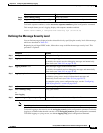
CHAPTER
30-1
Catalyst 2960 and 2960-S Switch Software Configuration Guide
OL-8603-09
30
Configuring SNMP
This chapter describes how to configure the Simple Network Management Protocol (SNMP) on the
Catalyst 2960 and 2960-S switches. Unless otherwise noted, the term switch refers to a standalone
switch and a switch stack.
Note Stacking is supported only on Catalyst 2960-S switches running the LAN base image.
For complete syntax and usage information for the commands used in this chapter, see the command
reference for this release and the Cisco IOS Network Management Command Reference, Release 12.4:
http://www.cisco.com/en/US/docs/ios/netmgmt/command/reference/nm_book.html
• Understanding SNMP, page 30-1
• Configuring SNMP, page 30-6
• Displaying SNMP Status, page 30-18
Understanding SNMP
SNMP is an application-layer protocol that provides a message format for communication between
managers and agents. The SNMP system consists of an SNMP manager, an SNMP agent, and a MIB.
The SNMP manager can be part of a network management system (NMS) such as CiscoWorks. The agent
and MIB reside on the switch. To configure SNMP on the switch, you define the relationship between
the manager and the agent.
The SNMP agent contains MIB variables whose values the SNMP manager can request or change. A
manager can get a value from an agent or store a value into the agent. The agent gathers data from the
MIB, the repository for information about device parameters and network data. The agent can also
respond to a manager’s requests to get or set data.
An agent can send unsolicited traps to the manager. Traps are messages alerting the SNMP manager to
a condition on the network. Traps can mean improper user authentication, restarts, link status (up or
down), MAC address tracking, closing of a TCP connection, loss of connection to a neighbor, or other
significant events.
The stack master handles the SNMP requests and traps for the whole switch stack. The stack master
transparently manages any requests or traps that are related to all stack members. When a new stack
master is elected, the new master continues to handle SNMP requests and traps as configured on the
previous stack master, assuming that IP connectivity to the SNMP management stations is still in place
after the new master has taken control.
For more information about switch stacks, see Chapter 7, “Managing Switch Stacks.”


















